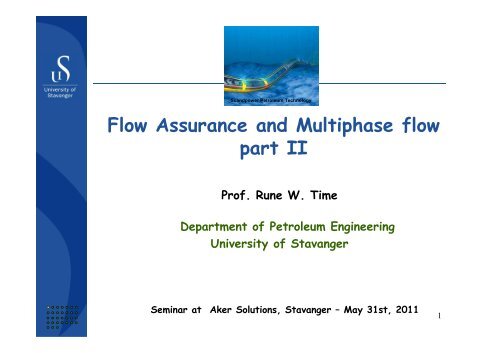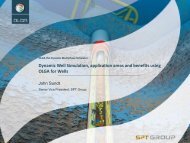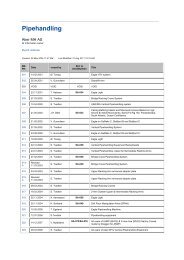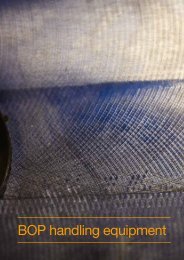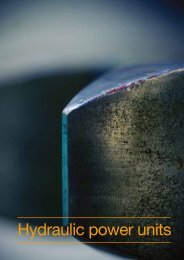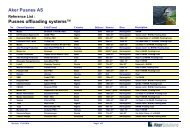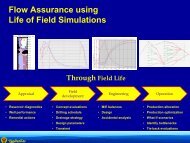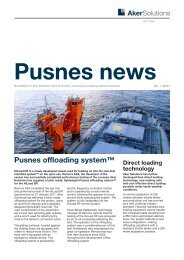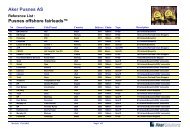Flow Assurance and Multiphase flow - part 2 By Prof ... - Aker Solutions
Flow Assurance and Multiphase flow - part 2 By Prof ... - Aker Solutions
Flow Assurance and Multiphase flow - part 2 By Prof ... - Aker Solutions
Create successful ePaper yourself
Turn your PDF publications into a flip-book with our unique Google optimized e-Paper software.
Sc<strong>and</strong>power Petroleum Technology<br />
<strong>Flow</strong> <strong>Assurance</strong> <strong>and</strong> <strong>Multiphase</strong> <strong>flow</strong><br />
<strong>part</strong> II<br />
<strong>Prof</strong>. Rune W. Time<br />
De<strong>part</strong>ment of Petroleum Engineering<br />
University of Stavanger<br />
Seminar at <strong>Aker</strong> <strong>Solutions</strong>, Stavanger – May 31st, 2011<br />
1
Outline <strong>and</strong> time schedule<br />
8.30 – 9.15 <strong>Flow</strong> regimes <strong>and</strong> impact on phase slippage,<br />
fluid concentrations <strong>and</strong> pressure drop in<br />
pipelines<br />
9.25 – 10.15 Hydrates, wax <strong>and</strong> asphaltenes<br />
10.25 -11.00 <strong>Multiphase</strong> <strong>flow</strong> – influence from interfaces,<br />
compression effects <strong>and</strong> waves<br />
Seminar at <strong>Aker</strong> <strong>Solutions</strong>, Stavanger - May31st, 2011<br />
2
PART II<br />
Hydrates, wax <strong>and</strong> asphaltenes<br />
+<br />
Scale, Emulsions <strong>and</strong> Erosion<br />
Seminar at <strong>Aker</strong> <strong>Solutions</strong>, Stavanger - May31st, 2011<br />
3
<strong>Flow</strong> assurance projects –Norway<br />
1993-1997: 1997: Statoilst <strong>Multiphase</strong> Technology Development<br />
Programme 1993-97. Summary “Cost savings through<br />
<strong>Multiphase</strong> <strong>Solutions</strong>”. Products:<br />
• Subsea multiphase meters <strong>and</strong> pumps<br />
• Long-lasting multiphase chokes<br />
• Mobile multi-test unit <strong>and</strong> total fluid management procedures<br />
• New industry st<strong>and</strong>ard d multiphase <strong>flow</strong> simulator<br />
• Increased c-steel pipeline applicability (NORSOK)<br />
• Leading edge hydrate mitigation procedures<br />
• Heated pipeline concepts for hydrate <strong>and</strong> wax control<br />
1995: A dedicated joint R&D programme<br />
between Statoil, Saga <strong>and</strong> Hydro (SSH)<br />
launched in 1995 with objective to improve the methodology<br />
for characterisation of dispersed multiphase systems <strong>and</strong><br />
technical ability to transport <strong>and</strong> effectively separate them.<br />
Seminar at <strong>Aker</strong> <strong>Solutions</strong>, Stavanger - May31st, 2011<br />
4
<strong>Flow</strong> assurance <strong>and</strong> precipitation of solids<br />
• Hydrates: Ice substance<br />
• Wax: Paraffine wax crystallic<br />
• Asphaltenes: Aromatic solids<br />
• Scale: Wall deposited heavy soluble mineral deposits<br />
In production oil systems very complex, heterogeneous <strong>and</strong><br />
some times even difficult to discrimate at first sight.<br />
Seminar at <strong>Aker</strong> <strong>Solutions</strong>, Stavanger - May31st, 2011<br />
5
Wax, asphaltenes <strong>and</strong> more ….<br />
Mercaptans are the most odoriferous<br />
substances known to mankind <strong>and</strong> are the<br />
substances found in Skunk k spray <strong>and</strong> the<br />
chemicals used to odorize natural gas, but<br />
in extremely low <strong>part</strong>s-per-billion<br />
concentrations.<br />
http://www.spentcaustic.com/tragedy.htm<br />
http://tigger.uic.edu/~mansoori/HOD_html<br />
Seminar at <strong>Aker</strong> <strong>Solutions</strong>, Stavanger - May31st, 2011<br />
also called thiols or organic sulfides<br />
6
Phase transitions<br />
7
Relevant phase transitions for <strong>flow</strong> assurance<br />
Seminar at <strong>Aker</strong> <strong>Solutions</strong>, Stavanger - May31st, 2011<br />
8
The long <strong>and</strong> transforming travel of oil<br />
from reservoir to tank<br />
Hydrates<br />
Asphaltenes<br />
Wax<br />
Seminar at <strong>Aker</strong> <strong>Solutions</strong>, Stavanger - May31st, 2011<br />
9
HYDRATES (Hammerschmidt, 1934)<br />
• Gas hydrates are crystalline materials where water molecules form a<br />
framework containing cavities which are occupied by individual gases or<br />
gas mixtures (e.g. methane, ethane, propane, isobutane <strong>and</strong> inorganic<br />
molecules such as CO2 <strong>and</strong> H2S).<br />
Ref: SSH <strong>Multiphase</strong> program: 235<br />
Appearance<br />
Hydrate gas loading<br />
Burning ice<br />
Seminar at <strong>Aker</strong> <strong>Solutions</strong>, Stavanger - May31st, 2011<br />
"Ice that burns" could<br />
provide enormous amounts<br />
of energy, but can it10<br />
be made<br />
environmentally friendly?<br />
(Image: USGS)
versus ice:<br />
Hydrate (clathrate) structures<br />
http://www.pet.hw.ac.uk/research<br />
/hydrate/hydrates_what.cfm<br />
”Cages” fit different molecules. How to know?<br />
- Chemical modelling (molecular dynamics)<br />
- Experiments (inhibitors)<br />
Seminar at <strong>Aker</strong> <strong>Solutions</strong>, Stavanger - May31st, 2011<br />
11
Hydrate <strong>flow</strong> assurance issues<br />
Hydrates?<br />
Gulf of Mexico – ”Horizon” 2010<br />
(Exam problem - <strong>Multiphase</strong> course)<br />
Environmental<br />
issues<br />
The drilling rig “Horizon” experienced a gas-kick k while drilling<br />
for BP in the Gulf of Mexico on April 21 st 2010. The rig sank <strong>and</strong><br />
oil leaked out from the well at a <strong>flow</strong> rate Q L = 10 L/s. Several<br />
methods have been proposed to prevent the oil from spreading<br />
on the sea surface. In one concept a large hood (funnel) as<br />
shown in the figure above will be positioned over the well head<br />
with a vertical pipeline system leading the oil up to the sea<br />
surface for collection.<br />
12<br />
Seminar at <strong>Aker</strong> <strong>Solutions</strong>, Stavanger - May31st, 2011
Hydrates <strong>and</strong> inhibitors<br />
• Hydrates form when light hydrocarbons meet with water,<br />
typically at T < 15° -25°C at elevated pressures.<br />
Conventional methods of<br />
hydrate control typically costs<br />
NOK 300 million for a field.<br />
Use of conventional inhibitors<br />
requires large storage tanks on<br />
the platforms <strong>and</strong> costly<br />
systems for injection <strong>and</strong><br />
possible regeneration.<br />
• “Thermodynamic” inhibitors (methanol or glycols) require concentrations<br />
around 30-70 % wt of water.<br />
• New low concentration inhibitors (LCI), conc. < 0.5 %wt , T< 5°C.<br />
Seminar at <strong>Aker</strong> <strong>Solutions</strong>, Stavanger - May31st, 2011<br />
13
Low Concentration Inhibitors (hydrate control)<br />
LCIs work in two different manners:<br />
1. The kinetic inhibitors impact on the kinetics, preventing or<br />
delaying hydrate formation.<br />
2. Hydrate modifiers allow hydrates to form, but as<br />
transportable <strong>part</strong>icles.<br />
Seminar at <strong>Aker</strong> <strong>Solutions</strong>, Stavanger - May31st, 2011<br />
14
Other hydrate mitigation techniques<br />
Direct electrical l heating:<br />
Åsgard field<br />
15<br />
Seminar at <strong>Aker</strong> <strong>Solutions</strong>, Stavanger - May31st, 2011
Cold <strong>flow</strong> principle - Sintef<br />
Stable dry hydrate<br />
slurry forms<br />
<strong>Flow</strong> from<br />
wells<br />
Hydrate<br />
recycle loop<br />
Hydrate recycle ’crash<br />
cools’ the incoming<br />
warm well stream<br />
16<br />
Seminar at <strong>Aker</strong> <strong>Solutions</strong>, Stavanger - May31st, 2011
Definition?<br />
ASPHALTENES<br />
(J.B. Boussingault , 1837)<br />
Asphaltenes are:<br />
- High molecular weight polycyclic organic compounds with nitrogen,<br />
oxygen <strong>and</strong> sulphur in their structure, in addition to carbon <strong>and</strong> hydrogen<br />
- Presence in petroleum fluids is defined as the fraction of petroleum fluid<br />
(or other carbonaceous sources such as coal), which is soluble in benzene<br />
<strong>and</strong> deposits, by addition of a low-boiling paraffin solvent.<br />
- Not crystallised upon deposition from petroleum fluids <strong>and</strong> as a result, its<br />
phase-transition from liquid to solid does not follow the same route as<br />
paraffin wax.<br />
- Not easily separated into individual purified components or fractions.<br />
Ultimate analysis not very significant, since resins are strongly adsorbed by<br />
asphaltenes - <strong>and</strong> not easily quantitatively separated from them.<br />
Ref: 09.IJOGCT.020203.MANSOORI<br />
Seminar at <strong>Aker</strong> <strong>Solutions</strong>, Stavanger - May31st, 2011<br />
17
Asphaltenes<br />
Benzene rings<br />
Cyclohexane rings<br />
Four different asphaltene<br />
structures separated<br />
from different natural<br />
petroleum fluids.<br />
Ref: 09.IJOGCT.020203.MANSOORI<br />
Seminar at <strong>Aker</strong> <strong>Solutions</strong>, Stavanger - May31st, 2011<br />
18
Asphaltenes - appearance<br />
Asphaltenes in North Sea crude oils North<br />
Sea crude oils generally contain 0.1-1.5 wt%<br />
asphaltenes (n-pentane insolubles).<br />
There are crude oils which contain more<br />
than 10 wt% asphaltenes.<br />
Asphaltenes may precipitate in pores<br />
near the well bore<br />
Asphaltenes in Ula separator<br />
Seminar at <strong>Aker</strong> <strong>Solutions</strong>, Stavanger - May31st, 2011<br />
19
Asphaltene risk in reservoirs<br />
Seminar at <strong>Aker</strong> <strong>Solutions</strong>, Stavanger - May31st, 2011<br />
Ref: SSH<br />
20
Dried asphaltenes<br />
http://baervan.nmt.edu/Petrophysics/group/intro-2-asphaltenes.pdf<br />
Figure 1. Examples of the appearance (magnified about 15 times) of asphaltenes separated from<br />
Mars-P crude oil with an excess of (a) n pentane (n-C5) <strong>and</strong> (b) n-heptane (n-C7).<br />
Some would argue that the n-C7 asphaltenes are the “real” asphaltenes, whereas the n-C5 material is a<br />
mixture of asphaltenes <strong>and</strong> resins.<br />
The “high end materials” in molecular weight, polarity <strong>and</strong> aromaticity — may separate into an<br />
asphaltene-rich phase in response to changes in pressure, composition, <strong>and</strong>/or temperature.<br />
Seminar at <strong>Aker</strong> <strong>Solutions</strong>, Stavanger - May31st, 2011<br />
21
When can asphaltenes cause problems?<br />
• Asphaltenes can cause problems in oil production, transportation, <strong>and</strong> processing.<br />
Amount of asphaltene in oil less important than asphaltene stability.<br />
• Stability depends on asphaltene properties, <strong>and</strong> solvent properties of the oil.<br />
• Light oils with small amounts of asphaltenes more likely to cause problems than<br />
heavy oil with larger amounts of material in the asphaltene fraction. Heavier oil also<br />
contains intermediate components that are good asphaltene solvents whereas the light<br />
oil consist largely of paraffinic materials in which, by definition, asphaltenes have very<br />
limited solubility.<br />
• Asphaltenes in heavier oils can also cause problems if they are destabilized by<br />
mixing with another crude oil during transportation or by other steps in oil processing.<br />
• Unstable asphaltenes can form separate phase that might plug the oil-bearing rock<br />
formation near a well. Can also aggregate at oil/water interfaces, stabilizing water-in-oil<br />
emulsions or at oil/solid interfaces<br />
• Can alter surface wetting properties or accumulate <strong>and</strong> plug well bores <strong>and</strong> <strong>flow</strong> lines.<br />
The first step toward predicting <strong>and</strong> avoiding any of these problems is knowing how to<br />
evaluate asphaltene stability.<br />
Seminar at <strong>Aker</strong> <strong>Solutions</strong>, Stavanger - May31st, 2011<br />
22
WAX<br />
Definitions<br />
What is wax?<br />
Mainly long-chain alkanes with 20-50 carbon atoms, but also contain minor quantities of<br />
branched <strong>and</strong> cyclic hydrocarbons. Typical content t in North Sea oils is 1-15 15 weight%.<br />
What is cloud point?<br />
Cloud point is the first temperature where wax starts to precipitate when an oil is cooled.<br />
It is often referred to as the wax appearance (or precipitation) temperature. Cloud point is<br />
typically 30-40°C, but may be as high as 50-55°C.<br />
What is wax melting point?<br />
The melting point of wax deposits is normally about 20°C higher than the cloud point.<br />
What is pour point <strong>and</strong> yield stress?<br />
Pour point is the temperature where sufficient amount of wax (about 4 weight %) is<br />
precipitated to make the oil take on a solid-like (gel) structure. The pour point of North<br />
Sea oils may be as high as 35°C <strong>and</strong> lower than -50°C. Below the pour point, the oil has a<br />
yield shear stress, i.e. the oil cannot <strong>flow</strong> unless it is subjected to a certain minimum<br />
shearing force (shaking or pumping). p Figure 3 shows a typical relationship between yield<br />
stress <strong>and</strong> restart pressure.<br />
23<br />
Seminar at <strong>Aker</strong> <strong>Solutions</strong>, Stavanger - May31st, 2011
Wax plugs<br />
Figure 1 Part of a wax plug retrieved from the pig trap at Statfjord B after pigging<br />
the pipeline from Snorre BtoStatfjord B (Sept. 2001)<br />
2006-Aberdeen-1-Tordal<br />
Seminar at <strong>Aker</strong> <strong>Solutions</strong>, Stavanger - May31st, 2011<br />
24
WATER-OIL EMULSIONS control<br />
Mixture<br />
versus<br />
emulsion<br />
Pipeline oil-water <strong>flow</strong><br />
Ref: L. Amundsen: PhD Thesis 2011, Helseth 2001<br />
What are emulsions?<br />
When water <strong>and</strong> oil are mixed, one of the phases is dispersed as droplets into the<br />
other. In oil production, water is most often the dispersed phase. Depending on the<br />
supply of mixing energy, the dispersion may separate readily into pure water <strong>and</strong><br />
pure oil, or it may stay as a stable emulsion.<br />
Emulsions are stabilised by components naturally present in the oil, such as<br />
asphaltenes, resins <strong>and</strong> organic acids. Solid <strong>part</strong>icles like wax, scale <strong>and</strong> fines may<br />
also act as stabilising agents.<br />
25<br />
Seminar at <strong>Aker</strong> <strong>Solutions</strong>, Stavanger - May31st, 2011
Water-oil emulsions li<br />
“ A dedicated di d joint R&D programme between Statoil, t Saga <strong>and</strong> Hydro (SSH) was<br />
launched in 1995 with the clear objective to improve the methodology for<br />
characterisation of dispersed multiphase systems <strong>and</strong> the technical ability to<br />
transport <strong>and</strong> effectively separate them ….”<br />
Seminar at <strong>Aker</strong> <strong>Solutions</strong>, Stavanger - May31st, 2011<br />
26
SCALE PRECIPITATION<br />
Figure 6.6 SrSO4 crystals<br />
precipitated from brine of<br />
SrSO4 supersaturatiori=5<br />
Figure 7.4 Crystals<br />
precipitated from static<br />
brine BSS3 at 70°C,<br />
(Ba+Sr)/SO4=1,<br />
Sr/Ba=1000<br />
What is oilfield scale?<br />
Oilfield scale is mainly deposits of<br />
inorganic salts such as carbonates <strong>and</strong><br />
sulphates of barium, strontium or<br />
calcium. Scale may also be salts of iron<br />
like sulphides, carbonates <strong>and</strong> hydrous<br />
oxides<br />
Figure 7.58 Crystals grown<br />
from 50:50 mixed North sea<br />
water <strong>and</strong> South Brae under<br />
static condition, 'tree leaves'<br />
crystals<br />
Ref: (Statoil,Saga,Hydro – <strong>Multiphase</strong> Technology Program)<br />
Ref: M. Yuan: PhD thesis, Heriot Watt, 1989<br />
Seminar at <strong>Aker</strong> <strong>Solutions</strong>, Stavanger - May31st, 2011<br />
27
Scale formation mechanisms<br />
Oilfield scale can form in one of<br />
two ways:<br />
Brine (e.g. formation water) may<br />
undergo change in conditions<br />
such as temperature or pressure.<br />
This generally gives rise to<br />
carbonate scales.<br />
Two incompatible ibl waters (e.g.<br />
formation water rich in calcium,<br />
strontium <strong>and</strong> barium <strong>and</strong> sea<br />
water rich in sulphate) mix.This<br />
generally gives rise to sulphate<br />
scales.<br />
The curves illustrate that calcite precipitation<br />
occurs by a positive feedback mechanism;<br />
pressure drop gives precipitation DP1 ,<br />
deposition gives a new pressure drop, DP2 ,<br />
which in turn gives increasing deposition,DP3 .<br />
Seminar at <strong>Aker</strong> <strong>Solutions</strong>, Stavanger - May31st, 2011<br />
28
Scale mitigation<br />
What is a scale inhibitor?<br />
Scale inhibitors are chemicals which stop or interfere with the<br />
nucleation, precipitation <strong>and</strong> adherence of mineral deposits.<br />
What is a scale dissolver?<br />
Scale dissolvers are chemicals which dissolve scale by complexing<br />
with ions like barium, strontium, calcium <strong>and</strong> iron.<br />
What is chelation or sequestration?<br />
Chelation or sequestration is the formation of soluble metal ion<br />
complexes in the presence of substances which normally would give<br />
a precipitate.<br />
Other techniques ?<br />
Electromagnetic<br />
Inhibition<br />
Seminar at <strong>Aker</strong> <strong>Solutions</strong>, Stavanger - May31st, 2011<br />
29<br />
http://www.ed2000.net/york/<br />
yk_theo_disc.htm
EROSION<br />
Erosion mechanisms <strong>and</strong> materials<br />
Seminar at <strong>Aker</strong> <strong>Solutions</strong>, Stavanger - May31st, 2011<br />
30
Erosion test of “IPC” downhole<br />
instrumentation system<br />
Project with <strong>Aker</strong> Maritime Well Services, 1998<br />
In<strong>flow</strong>, choke<br />
<strong>Multiphase</strong><br />
metering<br />
device<br />
Erosion test<br />
<strong>Flow</strong> regime<br />
dependence!<br />
<strong>Flow</strong><br />
direction<br />
31<br />
Seminar at <strong>Aker</strong> <strong>Solutions</strong>, Stavanger - May31st, 2011


